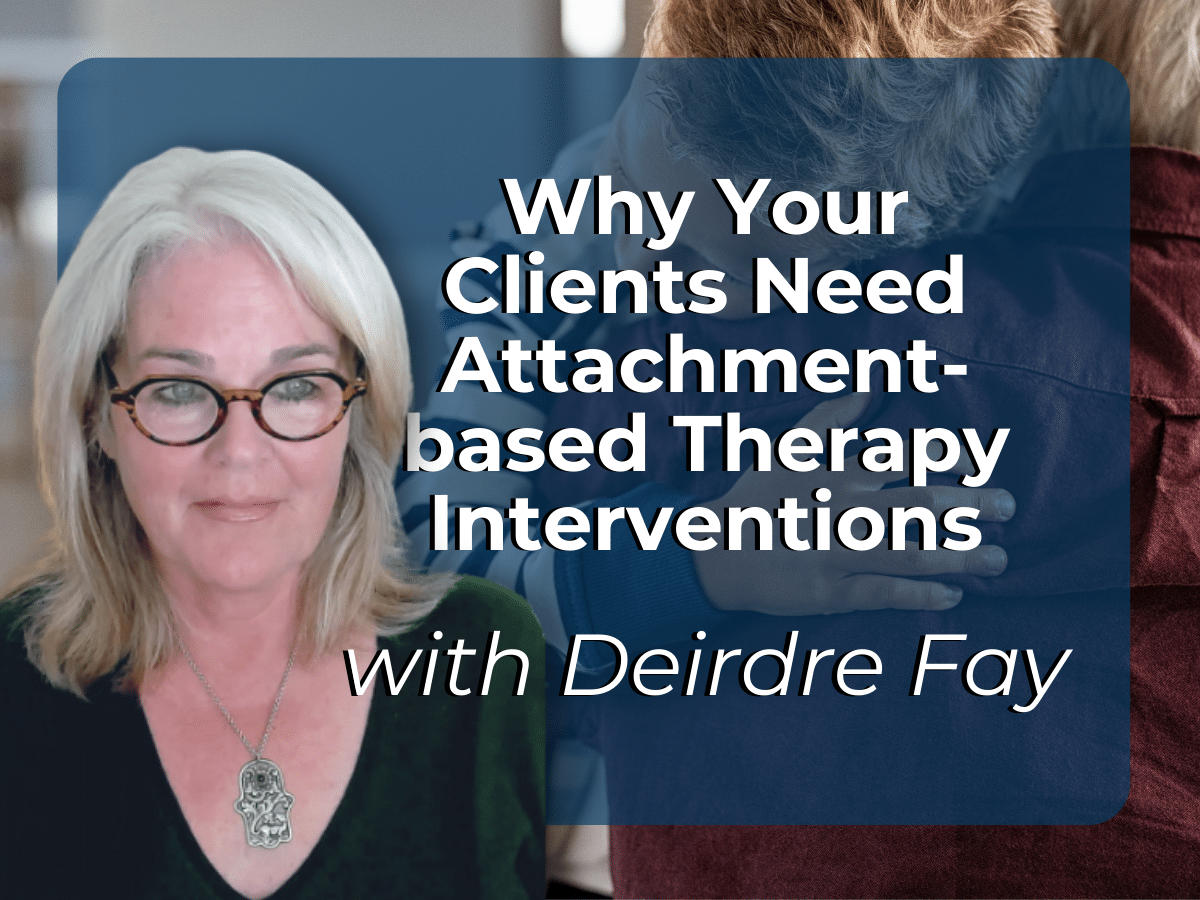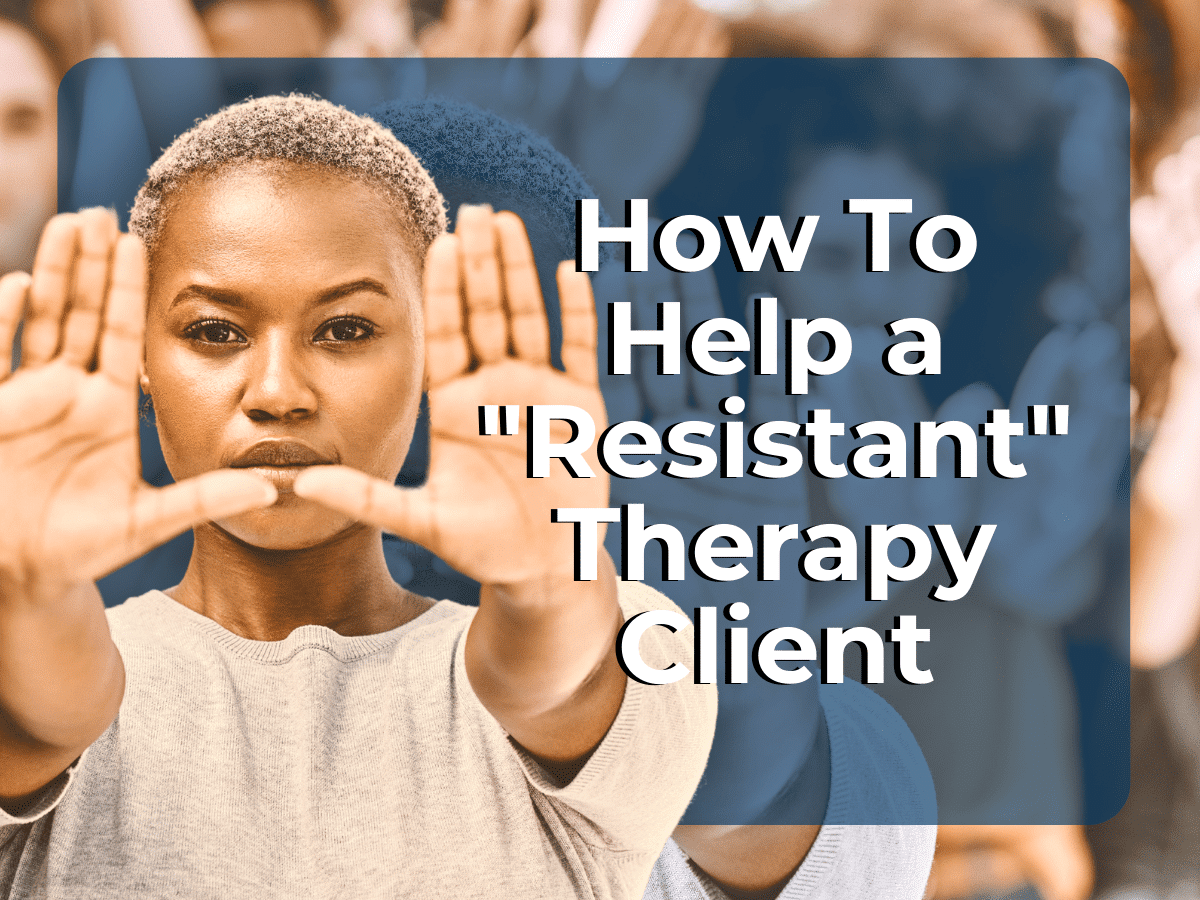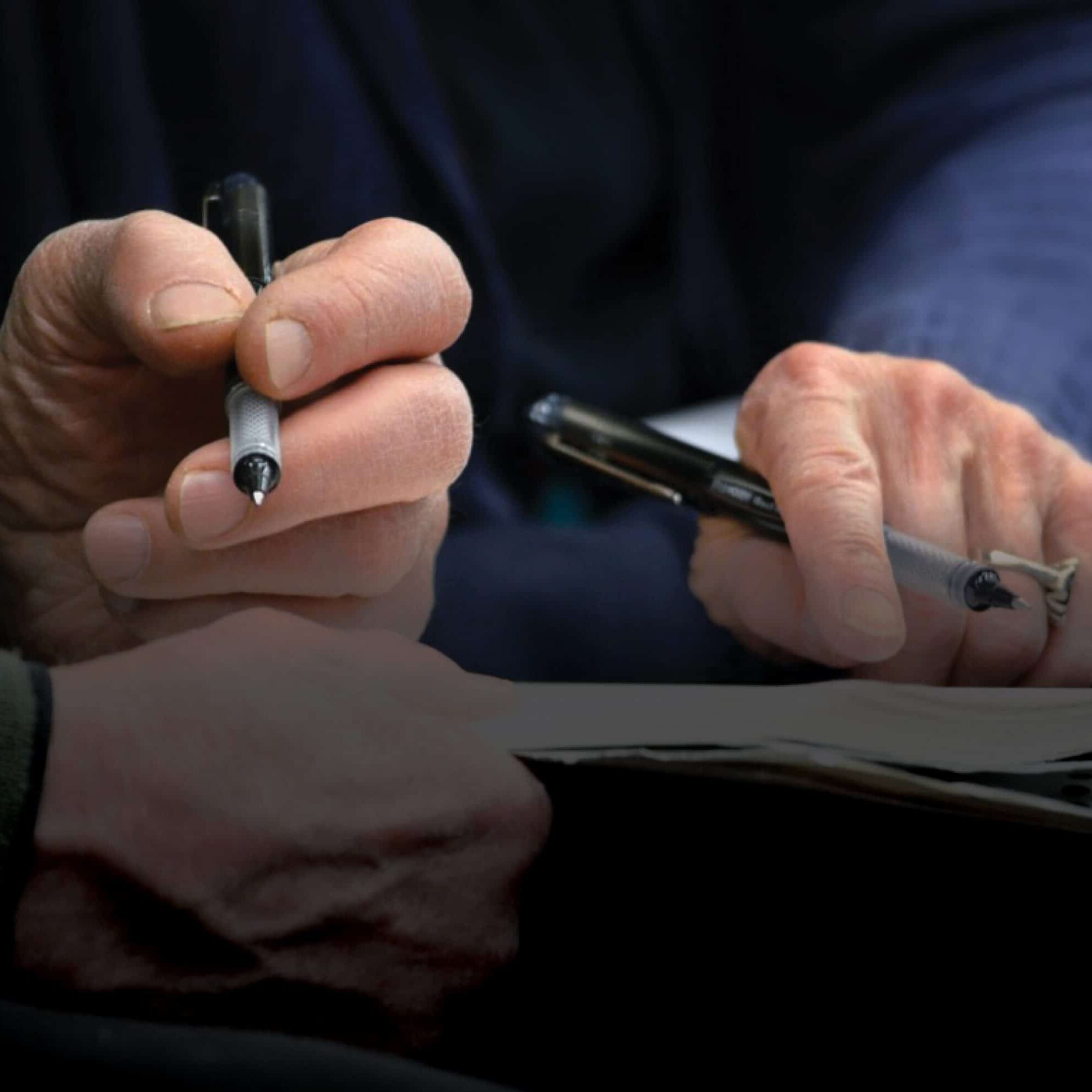Deirdre Fay is an embodied attachment expert who worked for years alongside luminaries like Janina Fisher and Bessel van der Kolk. She is a recognized expert in the field of trauma healing and treating adults with attachment disorder, and recently joined the Academy of Therapy Wisdom faculty. Her work is revolutionary and we think her techniques will revolutionize your sessions.
As she shares in the following video, attachment styles imprinted before the age of three shape how we experience the world (for better or for worse). For those of us who have disordered attachment styles, attachment-based therapy interventions can be the key to living a life with deep, loving relationships, a healthy sense of self-worth, and joyful fulfillment. Today, we share more about her work, and encourage our community to learn more about the life-changing therapy techniques that she teaches mental health professionals all over the world.
Why Attachment-based Interventions Are So Important in Therapy
As many of us have seen in our own private clinical psychology practice, unresolved attachment issues can hinder trauma recovery and personal growth. Deirdre helps us understand in her free attachment and trauma training how – regardless of what therapy modality you focus in – addressing these early relational patterns can be the key to unleashing healing and transformation. Invaluable tools like these help us to be more than therapists, they help us to be the guides to transformation we most want to be – the reason we became therapists in the first place.
Beyond Clinical Protocols: Attachment Therapy Supports Lasting Change
Deirdre believes, first and foremost, in being present and authentic. She calls us (and trains us HOW) to move beyond clinical protocols and techniques to form genuine connections with clients – connections that heal. Learn how to listen beneath the stories, bridging the gap between “doing” and “being,” and support lasting deep change in the lives of your psychotherapy clients.

JOIN a FREE Webinar Training with Deirdre Fay, MSW
Embodied Attachment: The Missing Piece In Trauma Healing
In this exclusive online session, participants will:
Gain clinical insights into the imprinting of a client’s attachment style.
Differentiate the missing attachment needs present in current triggers.
Learn to deconstruct and repattern the client’s Internal Working Model, as proposed by Bowlby.
Understand easy-to-apply techniques to diagram internal experiences, allowing clients to reflect, slow down, and make pattern-changing decisions.
5 Techniques for Attachment-based Therapy Work
- Be present and authentic
- Move beyond clinical protocols
- Form genuine connection with clients
- Listen beneath the stories clients tell
- Be more, do less
Learn more about these critical therapeutic skills in our free online attachment therapy training Embodied Attachment: The Missing Piece In Trauma Healing with Deirdre Fay. We promise you’ll leave the webinar with inspiring new insights and techniques that you can apply with your clients right away. We look forward to seeing you there!
Video transcript:
The big aha for me came after I’d been working with trauma clients, dissociative clients at Bessel Vander Kolk Clinic for probably 10, 15 years. I realized something was missing. What that big aha was then is when I took an attachment course and everything fell into place. That is why trauma doesn’t heal. That’s why it doesn’t clear.
So trauma treatment is so important because it helps stabilize and get a client a little bit more grounded, able to stay in the present moment. Then when that happens, all the rest of the stuff comes up. Then we start hearing what happened then relationally. And the problem is that these relational patterns are attachment styles that are imprinted before three years old. It’s really early. So that is imprinted in a nonverbal non-narrative way, as if it’s how we apprehend the world.
We don’t think about the world that early. That’s how we experience the world, right? It’s like the water that we’re swimming in and the air that we’re breathing. We almost can’t imagine it being any other way. And that pattern, as the research shows, is what rolls out over the rest of our lives unless we intervene. The research shows 77% of the people maintain their same attachment style throughout the years.
All the work that I had done, all the training, all the study with Bessel, with Janina, I was a trainer for sensory motor psychotherapy, I had done so much work, and yet I didn’t know this piece. And so much of attachment, healing is really about attunement.
It’s being able to drop all the protocols that I’ve learned all the right way to do it and just be there with them and listen underneath the story. I’ve had so many clients come in and have been with other therapists who are really well trained trauma therapists are certified in a certain modality. And yet the therapist ends up feeling like they can’t work with a client. And the client feels like there’s something wrong with them.
And the reason as I’ve been exploring this is that therapists are trained to do rather than to be. We have to drop that and learn how to be there and listen into and through the story. I’m Deirdre Fay. I’ve written two books, Becoming Safely Embodied and Attachment-Based Yoga and Meditation for Trauma, as well as co-authored a book with Dan Brown and David Elliott and a small group of others. The Becoming Safely Embodied skills came out of when I was at Bessel’s clinic and Bessel asked me to lead some groups.
And so I put together a series of groups and say, how do you learn to stabilize and live inside your body? And that became the basis. And then Janina was sending her clients to the group and seeing them change all the time. She was like, what are you doing? What’s making the difference here? And she came and joined me and we led the group for a number of years together. So I’m thinking about things like the story we all know about Helen Keller.
You know, she was blind, deaf, mute. And her amazing breakthrough was when she had a teacher, a boldly we’ll call an older, wiser person who was there with her, a guide, a mentor who helped her make sense of the world. There’s a wonderful story that they both talk about Helen Keller and the Insolvent, where Anne was trying to teach her what water was, and she had no concept for it. And so Anne took her hand, Helen Keller’s hand, put it in water so she could feel the water, and she started signing water, water. And Helen’s world completely opened up. That linkage happened. Oh, that’s what it is. The concept is no longer a concept. It makes sense of what’s happening inside. That’s what we’re doing over and over and over with our clients. I’m thinking of a client right now that I’m working with who is terrified of men, terrible history, and wanting to start dating but is terrified. We’re up a very violent family and household. And whenever she’s with people, she literally hears…screaming and yelling and running and her many different parts are scattering all over the place and she can’t stay present to the outside world because she’s in such inner conflict in turmoil.
She was describing about being at a book club and how she read this book but she didn’t really know anything about the characters or couldn’t really track the storyline and so she felt stupid and there was something wrong with her.
And this thought that there really is no place to be safe. I can’t be safe with people. Look at, I can’t even talk about this book that everybody’s read and something’s wrong with me. Then she paused and she said, but wow, this book was created by somebody’s imagination. That is so crazy. She said, I can’t even think about the characters that this person had, because this person must have had a good enough childhood that he could write this amazing story.
And then I mirrored that back and just acknowledged, like, so that is incredible. Like you could pick up this author’s energy. You were less interested in the story that this person was telling, but you could feel the energy that was there. And as I kept mirroring that and attuning to that, she said it was very calming to resonate with that, that who he was and the clarity that he had to share this, not just the storyline, but this energy with other people.
She said with me, and she starts crying, that I’m able to hold his book. She said, I’m really grateful that someone took a moment to put something together that I could be with in Landon. And it was a man, she said, and again, she’s crying. She said, a man who’s at peace.
And she said when she reads this book, her parts quiet down, not because of the story. Like she said, she still can’t really remember what the story is about, but something in her system is nourished by that. And she can’t believe that there’s a man who’s at peace. So her homework, I’m sure you would do something very similar, is to just have her absorb that, take that in, take in the peace.
And so what we’re doing is training her body, mind and heart that this experience in her, this peace, this being with men who are generous and kind and easy to be with and playful and creative, that’s the imprint that we’re trying to change. The attachment model is of scary men who are loud and violent and hurting other people.
So that’s the old, but…the more she lives within this new imprint, this new storyline, the more it’s gonna change and become more real. So here’s what you can do with yourself, with your clients, and just try it on, see if it works, if it resonates. I took the work of Bowlby and Robertson, looking at what happens to kids who’ve been removed from their families, even for good reason, and put in hospitals.
This happened during and after the war, when they were, trying to take care of these kids. And, Holby and Robertson noticed there were these three phases that kids went through. There’s the first, the really active protest, where they’re actively searching, they’re actively upset, tantruming, running around, looking, trying to get the attachment figure and trying to reconnect the distresses, or they want this attachment figure. And then, if that person doesn’t show up, they go into more of a sense of despair.
And then the final phase is detachment. We can think about it, detachment with our dissociative clients, this sense of vacancy that goes on. They’ve emotionally and psychologically distanced themselves from the wish, the hope, the want to even, that this attachment figure will return.
And to make it simple for clients, rather than trying to go through all that, make, try to break it all apart, I just started calling it all a protest. They’re upset. They know something’s wrong. It’s not fair. It’s not right. It shouldn’t be this way. They’re going to be simple little phrases that everybody comes up with. And so any upset like that comes up is just saying, of course you’re protesting.
There’s something that you want that isn’t being met. How normal. Whenever any of us say, well, it shouldn’t be like this. Right. Don’t we all do that? Like, it’s so normal. Something happens. We stub our toe. Oh, I don’t like it. We lose our keys. Oh, man. What’s that? And we go. We blame, we criticize, we make wrong. We do all kind of things. But so incredible. What inside of us knows it shouldn’t be like that. There’s some deep wisdom that we can tap into that says it shouldn’t be like that. Now we have to start listening and attuning. What do we know inside, deep down inside that it should be like? And how do we privilege that inner knowing that’s trying to direct us where we wanna go rather than staying caught in the loop of the protest over and over.
And life isn’t fair, and nothing works out, and we’re never gonna get right. When we start separating that out and giving room, something changes in all our lives. We begin to realize that our triggers, our upsets, our protests are a transformational tool to guide us back home to ourselves, to who we’ve always known and wanted to be, but got buried under by the pain of life and the suffering of life, the icky things that happen. And this is where having a psycho-spiritual orientation is helpful because we’re saying there’s something deep inside you, knows it should be different. Who is that? Who is that inside? You can call it soul, you can call it self, you can call it whatever language you wanna use or they use.
Something inside knows it should be different. So how do we tap into that stream and help them remember what they have forgotten so they can find their way back home to themselves? With this client I was just telling you about, she felt stupid, like there was something wrong with her that she couldn’t track the storyline and have an engaged intellectual conversation. So she was making herself wrong.
Instead of going with the protest, I was saying, let’s look at what’s there. What is calling to you? What’s underneath it? And they probably won’t know because most of us are trained in a world not to know, not to have needs because needs make us vulnerable and tender and needy. And that’s a really bad four or five-letter word. It’s like awful for most people. So we’re starting to normalize that and say, oh.
Of course you need that. Of course you need to be cared for and loved and valued and seen and known and appreciated. How normal. Of course you need help. Of course you need somebody to help break something big apart into small steps so you can take the step. Of course. Who doesn’t need that? We watch their bodies start relaxing. Like just even the simple bit about what’s the protest. And calling it a protest. And normalizing it. And validating it, reassuring them, this is of course, of course you’re upset, who wouldn’t be? Their whole being will start relaxing. That’s the basis of healing attachment theory.
If this way of working appeals to you or resonates with you, it’s really about getting a felt sense. Does this feel right to you? Then come join me in the course I’m doing with the Academy for Therapy Wisdom.
A New Attachment-based Therapy Course with Deirdre Fay
The first module is the clinical challenges we all face – looking at what’s going on and why a psychospiritual embodied approach is so important in integrating attachment theory to help our clients who are so severely wounded shift and change and have the life they want.
In module two, we’re going to look at what the attachment wounds are, and we’re going to look at the eight fundamental attachment needs that I’ve compiled as a starting point. We’re going to look at how do they show up. What happens if they don’t get met? And how do we shift them?
Module three is all about how to be with triggers and transforming the triggers, using them as a tool, a transformational tool. This is, okay, that’s the trigger, that’s the upset. Where do you want to go with it? Where is it pointing you to?
In module four, we’re going to look at repatterning these attachment styles so that it becomes something solid inside, embodied something that they can actually work on and not just have it be a thought process.
And module five is one of my favorite things to teach. How do we take a concept of something and make it so small, so granular, that somebody can just take the next step without creating a lot of fear and resistance and upset? Think about any of your clients. What do they really want? There’s some really essential things that we want.
We want to be loved. We want to feel safe. We want to be cared for. We want to feel safe to express ourselves, to be seen and known and valued, reassured, to be guided and mentored, to not take life personally, just be able to flow with life in a much more easy way. And these are what we’re going to look at. How do you make that so granular that you have it in your life and your life changes?
So I hope that intrigues you and interests you and that you’re gonna jump in because I can’t wait to see you and be with you in the course.



